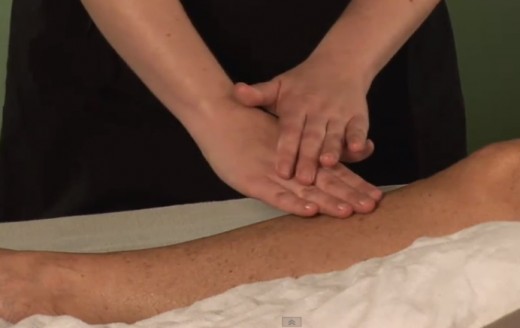Lymphedema
Lymphedema is a condition that causes swelling of one leg or arm but it can also at times cause the swelling of both legs or arms. The condition occurs when there is blockage of lymphatic system, which plays a role in circulatory and immune function. The swelling or inflammation is caused by build-up of fluid due to blockage on the lymphatic system. The lymphatic system consists of vessels that run throughout the body.
These lymph vessels collect excessive fluids, lipids, proteins and wastes from body tissue. The fluid is transported to lymph nodes where the waste is filtered and the fluid is returned to bloodstream. Primary lymphedema is an inherited condition that occurs due to anatomical abnormality within the lymph vessels. Secondary lymphedema occurs when there is damage or obstruction on otherwise previously normal lymph system.
Causes
The lymph system helps keep the body healthy by circulating fluid that collects microbes and waste products from the tissues and filtered by the lymph nodes. The wastes are filtered by lymphocytes, which are infection-fighting cells. After the filtering, the waste is flushed from body. When the lymph vessels cannot effectively drain the lymph fluid from an arm or leg, such a situation may lead to lymphedema.
Primary lymphedema is rare but it is an inherited condition. The cause of this condition may be due to Milroy’s disease, which starts at infancy and causes abnormalities on your lymph nodes. Another cause of primary lymphedema may be Meige’s disease, a hereditary condition that causes the lymph vessels to develop without valves that help regulate the backflow of the fluid. Lymphedema may also occur late at the age of around 35 years. This is called late onset lymphedema and is a primary form of the condition, which occurs due to abnormalities.
Secondary lymphedema is the most common form of this condition and is caused by a disease or condition that leads to the blockage of the lymph vessels. Damage of lymph vessels can be caused by a surgery where the vessels are cut such as during breast cancer surgery in which one or more nodes are removed from the armpit. If the retained lymph nodes and vessels cannot circulate the fluid as required, this may result to lymphedema.
Infection of the lymph nodes can cause restricted flow of lymph fluid. The blockage may also be caused by parasites that invade the lymph system. Filariasis causes blockage on lymph vessels where infestations by parasite called Wuchereria bancrofti occur in the lymph system. Cancer treatment methods like radiation and may also block the vessels or impair the function of the lymph nodes. The radiation can cause inflammation and scarring, which restricts the flow of fluid through the lymph system. A tumour growing near the lymph nodes could enlarge and cause blockage on the vessels making the flow of lymph fluid ineffective.
Lymphedema mainly affects one arm or leg but in rare cases, it can affect both arms or legs. The common symptoms of this condition include swelling of part of the arm or leg. At times, the swelling may cover the entire arm or leg including the toes and fingers. A person with the condition feels heaviness or tightness of the affected extremity whether the leg or arm. There is restricted range of motion accompanied by aching and discomfort in the extremity part of the body affected.
The affected limb may experience recurring infections. Other symptoms include hardening and thickening of skin on extremity. The swelling varies from mild to serious and while the mild swelling may have hardly noticeable change in arm size, on the other hand, severe swelling can occur which makes the limb impossible to move. If the lymphedema is caused by cancer, it may take months or several years before you notice the swelling.
The long-term accumulation of lymph fluid causes inflammation and scarred tissue, something that causes a firm and stiff swell, which may not retain its displacement when it is indented with a fingertip. The skin around the infected area may thicken and become lumpy, scaly, and cracked. The affected area also becomes tender, sore, and there is loss of mobility. Other symptoms include fatigue, weight loss, and embarrassment.
Although there is no cure for this condition, it can be managed by taking care of the affected extremity. The treatment therapies help in reducing inflammation and pain. Light exercise of the limb enhances the movement of lymph fluid. The exercises should be mild and not strenuous and should focus on the contraction of muscles in legs and arms.
Wrapping the limb with a bandage can encourage the fluid to flow back towards the trunk of the body. Massage, pneumatic compression, and compression garments are other ways, which can be used to help in fluid movement. If the lymphedema is severe, the doctor may consider use of surgery procedure to remove the excess tissue in leg and arm.
However, this only helps in reducing severe pain and it cannot cure lymphedema. A complete decongestive therapy involving several of treatments like message, pneumatic compression, and compression garment may be recommended in managing the inflammation but this therapy is not suitable for people with high blood pressure, heart failure, paralysis, and blood clots.




Lymphedema is a condition that causes swelling of one leg or arm but it can also at times cause the swelling of both legs or arms. The condition occurs when there is blockage of lymphatic system, which plays a role in circulatory and immune function. The swelling or inflammation is caused by build-up of fluid due to blockage on the lymphatic system. The lymphatic system consists of vessels that run throughout the body.
These lymph vessels collect excessive fluids, lipids, proteins and wastes from body tissue. The fluid is transported to lymph nodes where the waste is filtered and the fluid is returned to bloodstream. Primary lymphedema is an inherited condition that occurs due to anatomical abnormality within the lymph vessels. Secondary lymphedema occurs when there is damage or obstruction on otherwise previously normal lymph system.
Causes
The lymph system helps keep the body healthy by circulating fluid that collects microbes and waste products from the tissues and filtered by the lymph nodes. The wastes are filtered by lymphocytes, which are infection-fighting cells. After the filtering, the waste is flushed from body. When the lymph vessels cannot effectively drain the lymph fluid from an arm or leg, such a situation may lead to lymphedema.
Primary lymphedema is rare but it is an inherited condition. The cause of this condition may be due to Milroy’s disease, which starts at infancy and causes abnormalities on your lymph nodes. Another cause of primary lymphedema may be Meige’s disease, a hereditary condition that causes the lymph vessels to develop without valves that help regulate the backflow of the fluid. Lymphedema may also occur late at the age of around 35 years. This is called late onset lymphedema and is a primary form of the condition, which occurs due to abnormalities.
Secondary lymphedema is the most common form of this condition and is caused by a disease or condition that leads to the blockage of the lymph vessels. Damage of lymph vessels can be caused by a surgery where the vessels are cut such as during breast cancer surgery in which one or more nodes are removed from the armpit. If the retained lymph nodes and vessels cannot circulate the fluid as required, this may result to lymphedema.
Infection of the lymph nodes can cause restricted flow of lymph fluid. The blockage may also be caused by parasites that invade the lymph system. Filariasis causes blockage on lymph vessels where infestations by parasite called Wuchereria bancrofti occur in the lymph system. Cancer treatment methods like radiation and may also block the vessels or impair the function of the lymph nodes. The radiation can cause inflammation and scarring, which restricts the flow of fluid through the lymph system. A tumour growing near the lymph nodes could enlarge and cause blockage on the vessels making the flow of lymph fluid ineffective.
Symptoms of lymphedema
Lymphedema mainly affects one arm or leg but in rare cases, it can affect both arms or legs. The common symptoms of this condition include swelling of part of the arm or leg. At times, the swelling may cover the entire arm or leg including the toes and fingers. A person with the condition feels heaviness or tightness of the affected extremity whether the leg or arm. There is restricted range of motion accompanied by aching and discomfort in the extremity part of the body affected.
The affected limb may experience recurring infections. Other symptoms include hardening and thickening of skin on extremity. The swelling varies from mild to serious and while the mild swelling may have hardly noticeable change in arm size, on the other hand, severe swelling can occur which makes the limb impossible to move. If the lymphedema is caused by cancer, it may take months or several years before you notice the swelling.
The long-term accumulation of lymph fluid causes inflammation and scarred tissue, something that causes a firm and stiff swell, which may not retain its displacement when it is indented with a fingertip. The skin around the infected area may thicken and become lumpy, scaly, and cracked. The affected area also becomes tender, sore, and there is loss of mobility. Other symptoms include fatigue, weight loss, and embarrassment.
Treatment
Although there is no cure for this condition, it can be managed by taking care of the affected extremity. The treatment therapies help in reducing inflammation and pain. Light exercise of the limb enhances the movement of lymph fluid. The exercises should be mild and not strenuous and should focus on the contraction of muscles in legs and arms.
Wrapping the limb with a bandage can encourage the fluid to flow back towards the trunk of the body. Massage, pneumatic compression, and compression garments are other ways, which can be used to help in fluid movement. If the lymphedema is severe, the doctor may consider use of surgery procedure to remove the excess tissue in leg and arm.
However, this only helps in reducing severe pain and it cannot cure lymphedema. A complete decongestive therapy involving several of treatments like message, pneumatic compression, and compression garment may be recommended in managing the inflammation but this therapy is not suitable for people with high blood pressure, heart failure, paralysis, and blood clots.
Lymphedema Pictures




No comments:
Post a Comment